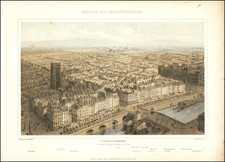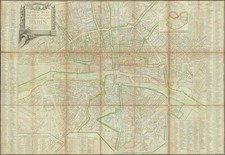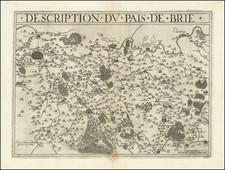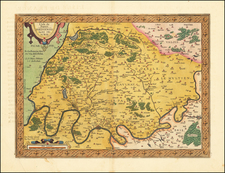Louis XIV's Paris and Versailles At The Height of His Reign As King of France
Rare variant edition of the 1705 edition of Nicolas De Fer's monumental Le Nouveau Plan de Paris Dresse sur le Memoires de Mr. Jouvin de Rochefort Tresorier de France, an expansive and intricate portrayal of Paris and the esteemed Versailles, at the zenith of French baroque grandiosity.
First published in 1697, the plan is enhanced with 24 detailed insets of Versailles and its surroundings and offers a comprehensive visual archive of royal opulence and architectural ingenuity of Versailles at the beginning of the 18th Century.
The present example includes both text panels at the sides and a special "Addition des Rues" added as an extra paste down at the lower half of each of the text columns.
Versailles and its splendors, along with other royal abodes associated with Louis XIV, including Saint-Germain-en-Laye, where he was born, are a feature of this plan. His military triumphs are commemorated in the Place des Victoires (1685) to the northeast of the Palais-Royal, and in the Place des Conquetes (begun in 1686). Originally designated as Place Vendome, because of the hotel of that name, and later as Place Louis-le-Grand, the Place des Conquetes depicted in De Fer's map is square and open on the south; this was a projected image only, and when it was completed in 1720 it was instead finished in in an octagonal shape. The Nouvelle Enceinte, planted with trees, follows the wall of Charles V and its prolongation under Louis XIII (1636) and is the site of the Grands Boulevards of today.
These vignettes showcase the grandeur of Versailles, the royal family’s residence, capturing its majestic gardens and elaborate water features. Key views include the grand perspective of Versailles, its satellite estates like Marli and Trianon, and the Menagerie, which was a showcase of exotic wildlife. The Chateau of Clagny, the estate of Meduon, and the intricate water features such as Bains d'Apollon, the aquatic theatre of Le Theatre d'Eau, and the famed Latona fountain are exquisitely detailed. The naturalistic spaces like Le Marais and the engineered marvels such as L'Arc de Triomphe and L'Encelade are also visually documented.
In addition to Versailles, the royal domain of St. Germaine en Laye, known for its historical château, is represented, along with L'Orangerie and the educational institution of St. Cyr, which Louis XIV founded for noble girls. The royal stables (les ecuries), the innovative Machine de Marly, which pumped water for the gardens of Versailles, and the labyrinthine gardens (Le Labirinthe) illustrate the vastness and sophistication of the king's projects.
Other monumental inclusions are the Potager du Roi, the forest palace of Fontainebleau, and the remarkable Girandole fountain. The Colonnade and the Galerie d'Eau, or the gallery of antiques, demonstrate the influence of classical antiquity on French royal art and architecture. Finally, the Salle du Bal, an open-air ballroom, and the expansive Grand Canal are illustrations of the lavish entertainments and leisure activities enjoyed by the court.
This plan serves as a testament to the era’s ambition to manifest heaven on earth, a conceptualization brought forth through landscape and stone, revealing much about the absolutist ideologies and aesthetic values of the time. The map not only delineates Paris as an urban entity but, with its detailed annotations and images, acts as an encyclopedia of royal estate, an invaluable tool for those seeking to understand the grandeur of French baroque landscape and architecture in the early 18th century.
Building Versailles
In 1623, Louis XIII, the King of France, constructed a modest hunting lodge in a location frequented for its game, 12 miles west of Paris and in proximity to his principal domicile at the Château de Saint-Germain-en-Laye. The chosen site, adjacent to the village of Versailles, was initially dismissed by the nobility as ill-befitting a monarch; however, between 1631 and 1634, this modest lodge was transformed by architect Philibert Le Roy into a more substantial château, albeit with restrictions placed by Louis XIII on overnight stays, even during a smallpox outbreak that necessitated his temporary relocation there with his young heir, the future Louis XIV, in 1641.
Upon Louis XIII's demise in 1643, Anne of Austria assumed the regency for the young Louis XIV, relocating the court to Paris. This period was marred by the Fronde (1648-1653), a series of uprisings challenging royal dominion, which fortified Louis XIV's resolve to govern without the interference of his mother or the princes of the blood. After Cardinal Mazarin's death in 1661, Louis XIV instituted governmental reforms and planned the expansion of his father's château at Versailles into a lavish palace.
Louis XIV, familiar with Versailles from hunts in the 1650s, developed a fascination with the site post-1661, especially after attending a festival at Nicolas Fouquet's Château de Vaux-le-Vicomte. Awed by its grandeur and the work of architect Louis Le Vau, landscaper André Le Nôtre, and painter Charles Le Brun, Louis XIV enlisted these visionaries for his own project at Versailles. Jean-Baptiste Colbert, succeeding Fouquet, oversaw the corps of artisans and facilitated the king's direct involvement in Versailles' evolution.
Initial enhancements at Versailles focused on its gardens, with modest architectural additions until 1668–69 when, spurred by military triumphs and a desire for a regal residence, Louis XIV encased the existing structure in an envelope, creating an Italianate façade that nonetheless clashed stylistically with the original courtyard. Despite efforts to unify the appearance, the death of Le Vau in 1670 left the project architecturally disjointed.
François d'Orbay continued the work, concentrating on interior grandeur and expanding the service wings. In 1670, he was commissioned to design a city named Versailles, to accommodate the burgeoning royal court. The conclusion of the Franco-Dutch War in 1678 enabled Jules Hardouin-Mansart to take the helm, initiating significant developments such as the Hall of Mirrors and the Ministers' Wings.
Subsequent wars in the late 17th century impeded further development, with the Nine Years' War halting all progress until 1698. However, by the turn of the century, resources were redirected towards a permanent palace chapel, culminating in its completion in 1710.
Louis XIV's successors, Louis XV and Louis XVI, primarily focused on the interior embellishment of Versailles. Louis XV initiated several projects, including the completion of the Salon d'Hercule and adjustments to the king's private apartments. Louis XVI's tenure witnessed limited structural changes due to financial and political constraints, leading up to the family's eventual departure from Versailles amidst the turmoil of the French Revolution in 1789.
Rarity
The plan is very rare on the market, with only a single example appearing at auctions reported by RBH.
The present example, with the text panels, is extremely rare. We were unable to locate another example.
Nicholas de Fer (1646-1720) was the son of a map seller, Antoine de Fer, and grew to be one of the most well-known mapmakers in France in the seventeenth century. He was apprenticed at twelve years old to Louis Spirinx, an engraver. When his father died in 1673, Nicholas helped his mother run the business until 1687, when he became the sole proprietor.
His earliest known work is a map of the Canal of Languedoc in 1669, while some of his earliest engravings are in the revised edition of Methode pour Apprendre Facilement la Geographie (1685). In 1697, he published his first world atlas. Perhaps his most famous map is his wall map of America, published in 1698, with its celebrated beaver scene (engraved by Hendrick van Loon, designed by Nicolas Guerard). After his death in 1720, the business passed to his sons-in-law, Guillaume Danet and Jacques-Francois Benard.













![[ Paris Wall Map ] Plan Geometral de Paris a L'Echelle de 0.001 pour 10 Metres ( 1/100,000)](https://storage.googleapis.com/raremaps/img/small/97781.jpg)
![[ Paris ] Plan Routier De La Ville et Faubourg De Paris 1772](https://storage.googleapis.com/raremaps/img/small/92313.jpg)